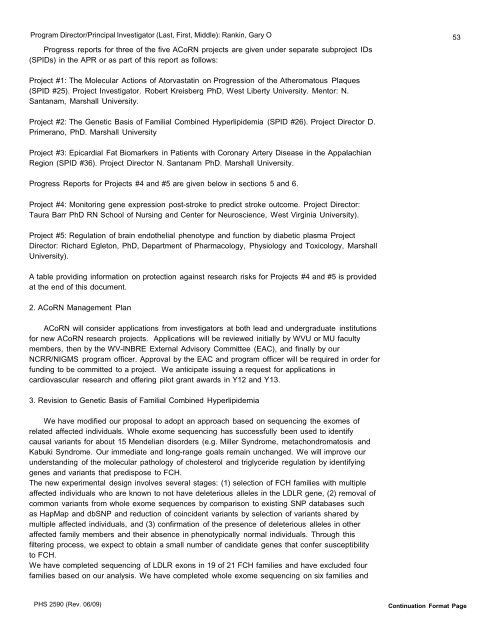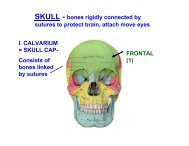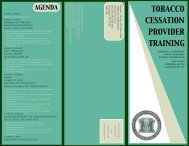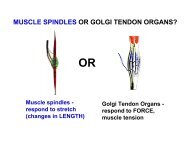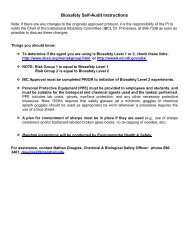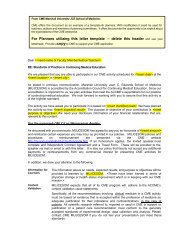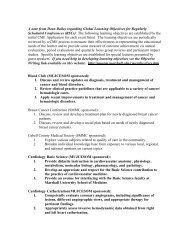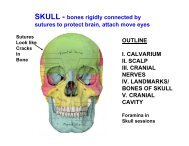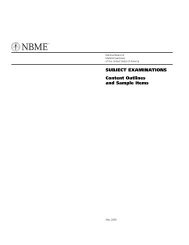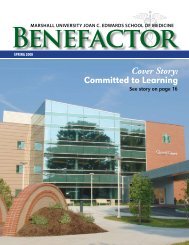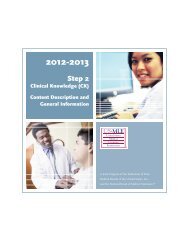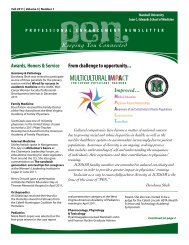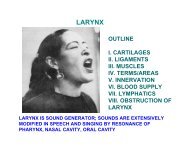FA 5 Progress Report WV-INBRE - Joan C. Edwards School of ...
FA 5 Progress Report WV-INBRE - Joan C. Edwards School of ...
FA 5 Progress Report WV-INBRE - Joan C. Edwards School of ...
- No tags were found...
You also want an ePaper? Increase the reach of your titles
YUMPU automatically turns print PDFs into web optimized ePapers that Google loves.
Program Director/Principal Investigator (Last, First, Middle): Rankin, Gary O 53<strong>Progress</strong> reports for three <strong>of</strong> the five ACoRN projects are given under separate subproject IDs(SPIDs) in the APR or as part <strong>of</strong> this report as follows:Project #1: The Molecular Actions <strong>of</strong> Atorvastatin on <strong>Progress</strong>ion <strong>of</strong> the Atheromatous Plaques(SPID #25). Project Investigator. Robert Kreisberg PhD, West Liberty University. Mentor: N.Santanam, Marshall University.Project #2: The Genetic Basis <strong>of</strong> Familial Combined Hyperlipidemia (SPID #26). Project Director D.Primerano, PhD. Marshall UniversityProject #3: Epicardial Fat Biomarkers in Patients with Coronary Artery Disease in the AppalachianRegion (SPID #36). Project Director N. Santanam PhD. Marshall University.<strong>Progress</strong> <strong>Report</strong>s for Projects #4 and #5 are given below in sections 5 and 6.Project #4: Monitoring gene expression post-stroke to predict stroke outcome. Project Director:Taura Barr PhD RN <strong>School</strong> <strong>of</strong> Nursing and Center for Neuroscience, West Virginia University).Project #5: Regulation <strong>of</strong> brain endothelial phenotype and function by diabetic plasma ProjectDirector: Richard Egleton, PhD, Department <strong>of</strong> Pharmacology, Physiology and Toxicology, MarshallUniversity).A table providing information on protection against research risks for Projects #4 and #5 is providedat the end <strong>of</strong> this document.2. ACoRN Management PlanACoRN will consider applications from investigators at both lead and undergraduate institutionsfor new ACoRN research projects. Applications will be reviewed initially by <strong>WV</strong>U or MU facultymembers, then by the <strong>WV</strong>-<strong>INBRE</strong> External Advisory Committee (EAC), and finally by ourNCRR/NIGMS program <strong>of</strong>ficer. Approval by the EAC and program <strong>of</strong>ficer will be required in order forfunding to be committed to a project. We anticipate issuing a request for applications incardiovascular research and <strong>of</strong>fering pilot grant awards in Y12 and Y13.3. Revision to Genetic Basis <strong>of</strong> Familial Combined HyperlipidemiaWe have modified our proposal to adopt an approach based on sequencing the exomes <strong>of</strong>related affected individuals. Whole exome sequencing has successfully been used to identifycausal variants for about 15 Mendelian disorders (e.g. Miller Syndrome, metachondromatosis andKabuki Syndrome. Our immediate and long-range goals remain unchanged. We will improve ourunderstanding <strong>of</strong> the molecular pathology <strong>of</strong> cholesterol and triglyceride regulation by identifyinggenes and variants that predispose to FCH.The new experimental design involves several stages: (1) selection <strong>of</strong> FCH families with multipleaffected individuals who are known to not have deleterious alleles in the LDLR gene, (2) removal <strong>of</strong>common variants from whole exome sequences by comparison to existing SNP databases suchas HapMap and dbSNP and reduction <strong>of</strong> coincident variants by selection <strong>of</strong> variants shared bymultiple affected individuals, and (3) confirmation <strong>of</strong> the presence <strong>of</strong> deleterious alleles in otheraffected family members and their absence in phenotypically normal individuals. Through thisfiltering process, we expect to obtain a small number <strong>of</strong> candidate genes that confer susceptibilityto FCH.We have completed sequencing <strong>of</strong> LDLR exons in 19 <strong>of</strong> 21 FCH families and have excluded fourfamilies based on our analysis. We have completed whole exome sequencing on six families andPHS 2590 (Rev. 06/09)Continuation Format Page


